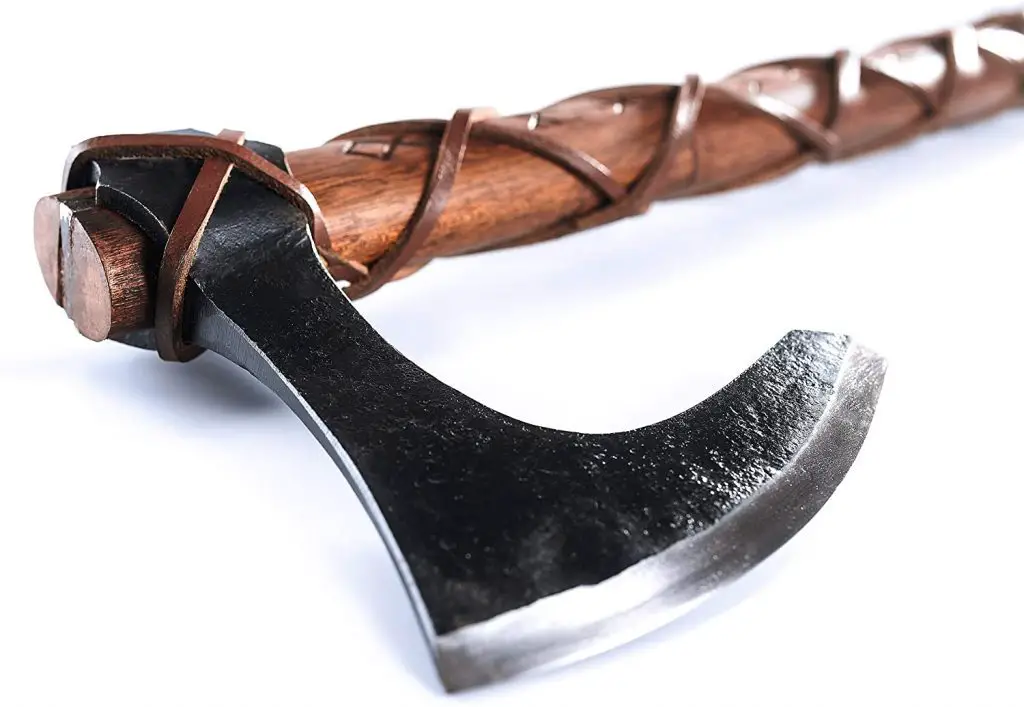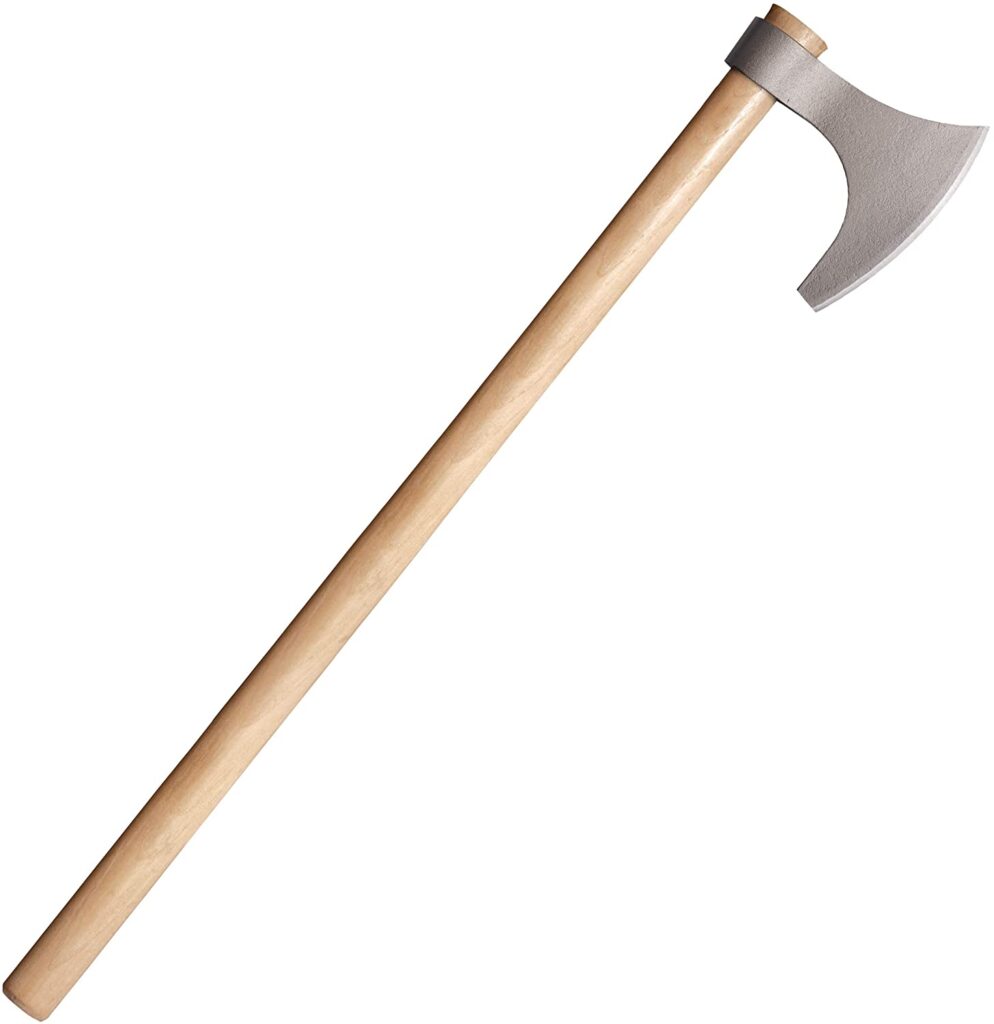A battle axe is a historical weapon, typically featuring a large, sharp blade mounted on a long handle or haft. Various cultures and civilizations used it as a melee weapon for close combat, and a throwing implement. Battle axes were prominent in warfare before the widespread use of firearms.
You might have seen battle axes in movies about Vikings. These are one of the most known axes but are not used today for the same purpose, i.e., fighting in battles. However, battle axes are still manufactured, although their primary use is decorative.
Table of Contents
Purpose
As the name suggests, a battle axe was a type of weapon primarily used in battle. This axe was designed for combat in ancient warfare. It features one or two crescent-shaped blades. These blades come in different sizes and can almost instantly cut anything they encounter.
The battle axe can be as long as seven feet and as small as three feet. Besides that, the battle axe also has a thick, light metallic handle that makes it easy to grip. The first axe was made in 6,000 B.C.E. by the Romans. You can also find the use of axes in the history of Normans, Vikings, Napoleonic troops, and ancient chinless warriors.
Since this axe was designed for battle, there are few uses for these axes in modern times. Here is the purpose of battle axes:
- Used for hand-to-hand fighting
- Used to throw
- Used as a shield
Although people don’t use battle axes today for combat, they are still popular among people due to their unique shape and great role in ancient battles. They are primarily used as props or decorative.

Design and Features
Battle axes have a unique design. They usually remind me of Vikings, as I have seen several historically accurate moves in which Vikings have used these weapons to fight their enemies. These axes look a bit horrifying, especially the bigger ones. The extremely sharp blades on both ends can frighten anyone who sees it.
Here are a few attributes of battle axes:
- 3 to 7-foot-long wooden handle
- 1 to 7 pounds in weight
- Different sizes of blades
- Either single or double-bit blades
- Round handle
- Leather grip
The blades on both ends helped warriors to fight with people from every angle without turning their weapons over to fight a second combatant.
In the 20th century, people us battle axe for décor. Weapon and art lovers hang them in their offices or living rooms. They have an aesthetically pleasing appearance that improves the ambiance of any space. Some people also purchase battle axes to keep them in their weapon collection.
Do you love Halloween? Want to create a Viking look? Then, you will need a battle axe to impress others with your costume. Of course, you must create a complete look, such as getting a long beard and hat to get the Viking look.
I have put together a full guide looking at replica Viking axes being made today if you want to get your own battle axe.
You can also find bearded axes where the toe of the blade extends below the shoulder of the axe, protecting the top handle during battle.
Modern Brands
If you Google “battle axes,” you can find pictures of ancient battle axes. The axes of that time were long, usually similar to the user’s height, with large blades. Of course, the axes you can find in today’s market are not huge and heavy. They are more compact and light and have an entertaining element, as people use them for fun.
The most appealing part of modern brands is that they offer amazingly designed axes. From handles to blades, battle axes have an artistic appeal. You can find many axes with unique carvings on the blades. Some axes also have a rustic look to mimic the look of ancient battle axes. If you want to create a custom design to gift to your friends or peers, you can find companies that offer these services.
Another thing about contemporary designs is that they come in different materials, like metal, wood, and plastic. Material is the main factor in choosing the product, as they decide its longevity and how light the axe will be.
Here are some brands that offer you durable and premium quality products.
- Estwing
- ForgedCommoditiesUSA
- Wuu Jau Co
- Hero’s Edge
- Generic
- BladesUSA

How to Choose a Battle Axe?
You can choose a battle axe based on its purpose and budget. Also, look for reliable and credible brands that offer quality products. The size, shape, and color of axes also matter. It’s best to look for several options, narrow down the best ones, and pick one.
The first step in choosing a battle axe is to determine its purpose. Are you looking for a decorative piece, a practical tool for outdoor activities such as camping, or a functioning weapon for reenactment events or martial arts practice? The intended use will guide your decision about the axe’s size, weight, and materials.
Battle axes can range significantly in price, so it’s essential to establish a budget. Remember that more expensive axes are usually made of higher-quality materials and may be hand-forged. Cheaper axes might not be as durable or well-balanced, which could affect their usability.
Do some research to find manufacturers known for their quality and reliability. You can find reviews and testimonials online, or ask for recommendations from experienced users or enthusiasts. Some well-known brands for historical accuracy or functionality could include Cold Steel, Hanwei, or Arms & Armor.
The size and weight of the battle axe should be comfortable for you to handle. Longer, heavier axes can deliver more force but may be more challenging to control, especially for those without much strength or training. Conversely, shorter, lighter axes might be easier to manage but may not have as much impact.
The axe’s shape and materials can greatly affect its performance and durability. A good axe blade is typically made from high-carbon steel, which is strong and holds an edge well, but it may rust if not properly cared for. Stainless steel is more resistant to rust but doesn’t hold an edge as well. The shape of the axe head – be it bearded, broad, or narrow – will also impact how it can be used.
If the aesthetics of the axe are important to you, consider its design and color. Some may prefer a traditional, historical look, while others want a more modern or fantasy-inspired design. The color of the axe, usually determined by the materials used and the finish applied, could range from silver and black for steel axes to various shades of brown for wooden handles.
